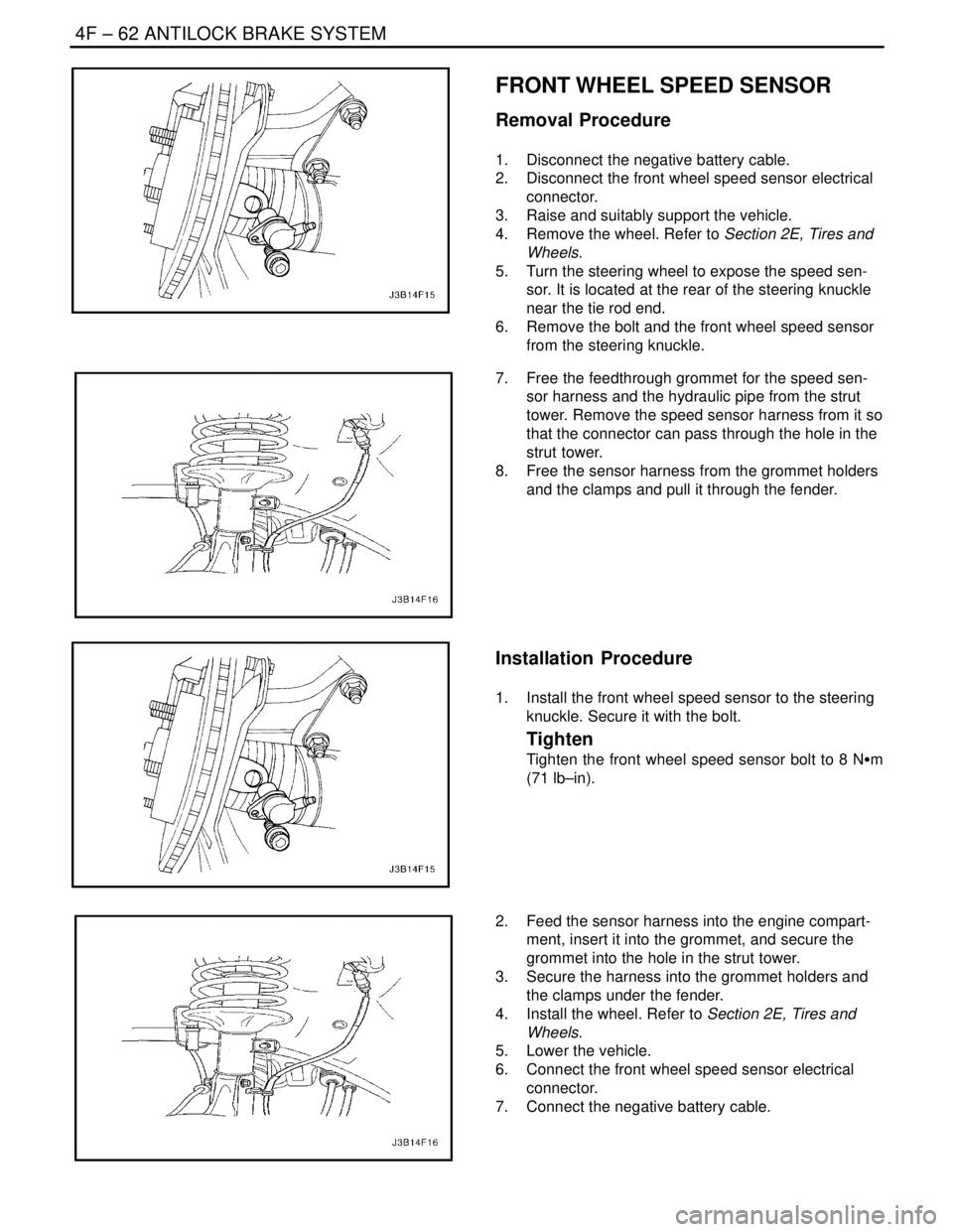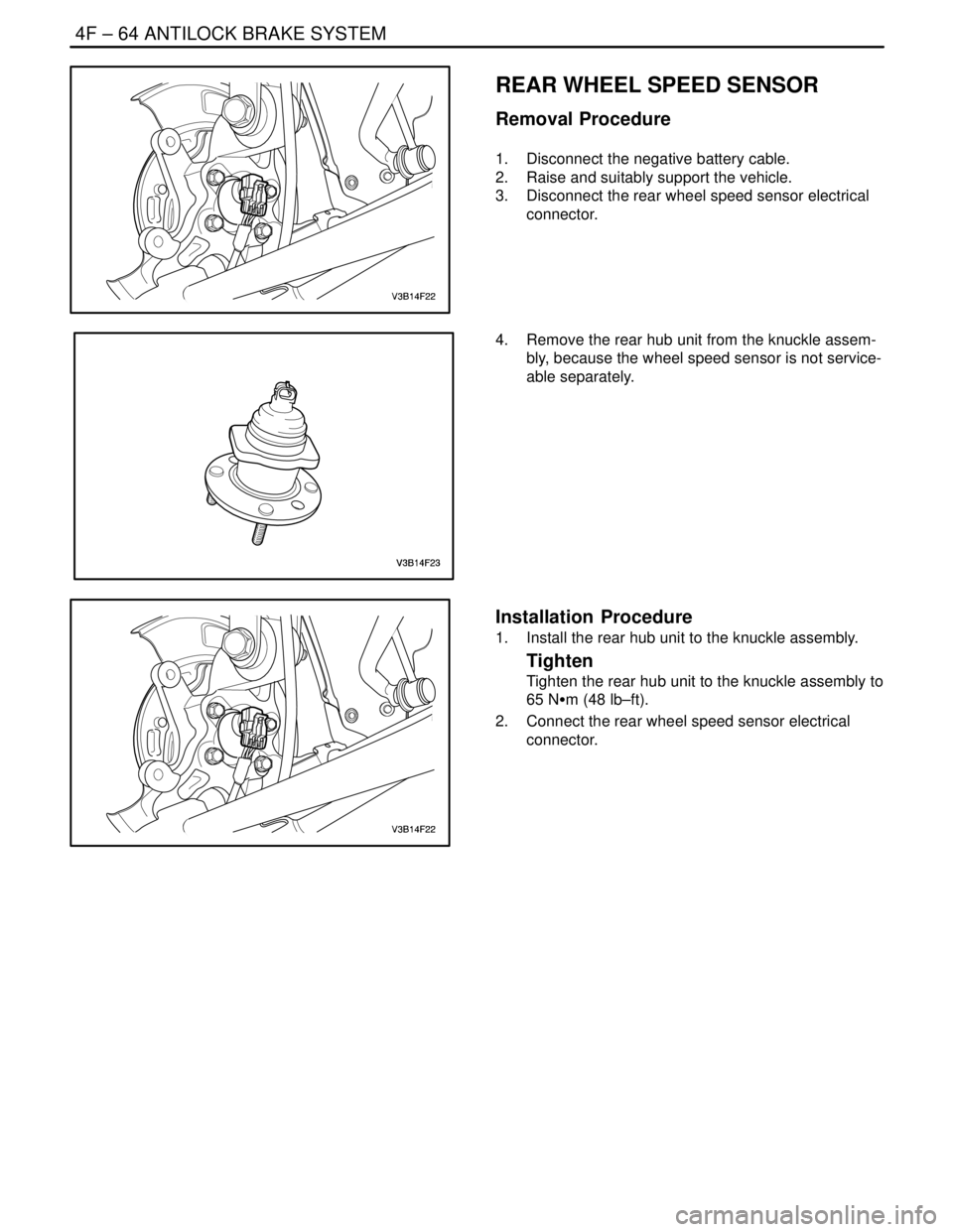2004 DAEWOO LACETTI vehicle speed sensor
[x] Cancel search: vehicle speed sensorPage 1143 of 2643

4F – 62IANTILOCK BRAKE SYSTEM
DAEWOO V–121 BL4
FRONT WHEEL SPEED SENSOR
Removal Procedure
1. Disconnect the negative battery cable.
2. Disconnect the front wheel speed sensor electrical
connector.
3. Raise and suitably support the vehicle.
4. Remove the wheel. Refer to Section 2E, Tires and
Wheels.
5. Turn the steering wheel to expose the speed sen-
sor. It is located at the rear of the steering knuckle
near the tie rod end.
6. Remove the bolt and the front wheel speed sensor
from the steering knuckle.
7. Free the feedthrough grommet for the speed sen-
sor harness and the hydraulic pipe from the strut
tower. Remove the speed sensor harness from it so
that the connector can pass through the hole in the
strut tower.
8. Free the sensor harness from the grommet holders
and the clamps and pull it through the fender.
Installation Procedure
1. Install the front wheel speed sensor to the steering
knuckle. Secure it with the bolt.
Tighten
Tighten the front wheel speed sensor bolt to 8 NSm
(71 lb–in).
2. Feed the sensor harness into the engine compart-
ment, insert it into the grommet, and secure the
grommet into the hole in the strut tower.
3. Secure the harness into the grommet holders and
the clamps under the fender.
4. Install the wheel. Refer to Section 2E, Tires and
Wheels.
5. Lower the vehicle.
6. Connect the front wheel speed sensor electrical
connector.
7. Connect the negative battery cable.
Page 1145 of 2643

4F – 64IANTILOCK BRAKE SYSTEM
DAEWOO V–121 BL4
REAR WHEEL SPEED SENSOR
Removal Procedure
1. Disconnect the negative battery cable.
2. Raise and suitably support the vehicle.
3. Disconnect the rear wheel speed sensor electrical
connector.
4. Remove the rear hub unit from the knuckle assem-
bly, because the wheel speed sensor is not service-
able separately.
Installation Procedure
1. Install the rear hub unit to the knuckle assembly.
Tighten
Tighten the rear hub unit to the knuckle assembly to
65 NSm (48 lb–ft).
2. Connect the rear wheel speed sensor electrical
connector.
Page 1146 of 2643

ANTILOCK BRAKE SYSTEM 4F – 65
DAEWOO V–121 BL4
GENERAL DESCRIPTION AND SYSTEM
OPERATION
BASIC KNOWLEDGE REQUIRED
Before using this section, it is important that you have a ba-
sic knowledge of the following items. Without this knowl-
edge, it will be difficult to use the diagnostic procedures
contained in this section.
S Basic Electrical Circuits : You should understand
the basic theory of electricity and know the mean-
ing of voltage, current (amps), and resistance
(ohms). You should understand what happens in a
circuit with an open or shorted wire. You should be
able to read and understand a wiring diagram.
S Use of Circuit Testing Tools : You should know how
to use a test light and how to bypass components
to test circuits using fused jumper wires. You should
be familiar with a digital multimeter. You should be
able to measure voltage, resistance, and current,
and be familiar with the controls and how to use
them correctly.
ABS SYSTEM COMPONENTS
The ABS 5.3 Antilock Braking System (ABS) consists of
a conventional hydraulic brake system plus antilock com-
ponents. The conventional brake system includes a vacu-
um booster, master cylinder, front disc brakes, rear lead-
ing/trailing drum brakes, interconnecting hydraulic brake
pipes and hoses, brake fluid level sensor and the BRAKE
indicator.
The ABS components include a hydraulic unit, an elec-
tronic brake control module (EBCM), two system fuses,
four wheel speed sensors (one at each wheel), intercon-
necting wiring, the ABS indicator, the EBD indicator (which
is connected to the parking lamp) and the rear disk brakes.
See “ABS Component Locator” in this section for the gen-
eral layout of this system.
The hydraulic unit with the attached EBCM is located be-
tween the surge tank and the fire wall on the left side of the
vehicle.
The basic hydraulic unit configuration consists of hydraulic
check valves, two solenoid valves for each wheel, a hy-
draulic pump, two accumulators, and two damper. The hy-
draulic unit controls hydraulic pressure to the front calipers
and rear wheel cylinders by modulating hydraulic pressure
to prevent wheel lockup.
Nothing in the hydraulic unit or the EBCM is serviceable.
In the event of any failure, the entire ABS unit with at-
tached EBCM must be replaced. For more information, re-
fer to ”Base Braking Mode” and ”Antilock Braking Mode”
in this section.
BASE BRAKING MODE
The baseline braking mode of the ABS 5.3 system used
in this vehicle is a diagonal split system. In this system,
one master cylinder circuit supplies pressure to the right
front and the left rear brakes; the other circuit supplies
pressure to the left front and the right rear brakes. All
valves in the hydraulic modulator are in their normal, non–
energized positions as shown in the drawings found in
”ABS System Components” in this section.
Page 1150 of 2643

ANTILOCK BRAKE SYSTEM 4F – 69
DAEWOO V–121 BL4
EBD (ELECTRONIC BRAKE FORCE
DISTRIBUTION) SYSTEM
As an add–on logic to the ABS base algorithm, EBD works
in a range in which the intervention thresholds for ABS
control are not reached yet.
EBD ensures that the rear wheels are sensitively moni-
tored for slip with respect to the front axle. If slip is de-
tected, the inlet valves for the rear wheels are switched to
pressure hold to prevent a further increase in pressure at
the rear–wheel breaks, thus electronically reproducing a
pressure–reduction function at the rear–wheel brakes.
THE BENEFITS OF EBD
S Elimination of conventional proportioning valve.
S EBD utilizes the existing rear axle wheel speed
sensor to monitor rear wheel slip.
S Based on many variables in algorithm a pressure
hold, increase and/or decrease pulsetrain may be
triggered at the rear wheels insuring vehicle stabil-
ity.
S Vehicle approaches the ideal brake force distribu-
tion. (front to rear)
S Constant brake force distribution during vehicle life-
time.
S EBD function is monitored via ABS safety logic.
(conventional proportioning valves are not monitor-
able)
S ”Keep alive” function.
Page 1152 of 2643

ANTILOCK BRAKE SYSTEM 4F – 71
DAEWOO V–121 BL4
TIRES AND ABS/EBD
Replacement Tires
Tire size is important for proper performance of the ABS
system. Replacement tires should be the same size, load
range, and construction as the original tires. Replace tires
in axle sets and only with tires of the same tire perfor-
mance criteria (TPC) specification number. Use of any
other size or type may seriously affect the ABS operation.
TIRES AND ABS/EBD
Notice : There is no serviceable or removable EEPROM.
The EBCM must be replaced as an assembly.
The EBCM is attached to the hydraulic unit in the engine
compartment. The controlling element of ABS 5.3 is a mi-
croprocessor–based EBCM. Inputs to the system include
the four wheel speed sensors, the stoplamp switch, the
ignition switch, and the unswitched battery voltage. There
is an output to a bi–directional serial data link, located in
pin K of Data Link Connector (DLC) for service diagnostic
tools and assembly plant testing.
The EBCM monitors the speed of each wheel. If any wheel
begins to approach lockup and the brake switch is closed
(brake pedal depressed), the EBCM controls the sole-
noids to reduce brake pressure to the wheel approaching
lockup. Once the wheel regains traction, brake pressure
is increased until the wheel again begins to approach lock-
up. This cycle repeats until either the vehicle comes to a
stop, the brake pedal is released, or no wheels approach
lockup.
Additionally, the EBCM monitors itself, each input (except
the serial data link), and each output for proper operation.
If it detects any system malfunction, the EBCM will store
a DTC in nonvolatile memory (EEPROM) (DTCs will not
disappear if the battery is disconnected). Refer to ”Self
Diagnostics” in this section for more detailed information.
FRONT WHEEL SPEED SENSOR
The front wheel speed sensors are of a variable reluctance
type. Each sensor is attached to the steering knuckle,
close to a toothed ring. The result, as teeth pass by the
sensor, is an AC voltage with a frequency proportional to
the speed of the wheel. The magnitude of the voltage and
frequency increase with increasing speed. The sensor is
not repairable, nor is the air gap adjustable.
FRONT WHEEL SPEED SENSOR
RINGS
The toothed ring mentioned above is pressed onto the
wheel–side (outer) constant velocity joint. Each ring con-
tains 47 equally spaced teeth. Exercise care during ser-
vice procedures to avoid prying or contacting this ring. Ex-cessive contact may cause damage to one or more teeth.
If the ring is damaged, the wheel–side constant velocity
joint must be replaced.
REAR WHEEL SPEED SENSOR AND
RINGS
The rear wheel speed sensors operate in the same man-
ner as the front wheel speed sensors. They incorporate a
length of flexible harness with the connector attached to
the end of the harness. The rear wheel speed rings are in-
corporated into the hub assemblies and cannot be re-
placed separately, but require replacement of the rear
hub/bearing assembly.
VALUE RELAY AND PUMP MOTOR
RELAY
The valve relay and the motor pump relay are located in-
side the electronic brake control module (EBCM) and are
not replaceable. If one should fail, replace the EBCM.
WIRING HARNESS
The wiring harness is the mechanism by which the elec-
tronic brake control module (EBCM) is electrically con-
nected to power and to ground, to the wheel speed sen-
sors, the fuses, the switches, the indicators, and the serial
communications port. The components, considered part
of the wiring harness, are the wires that provide electrical
interconnection, and connectors (terminals, pins, con-
tacts, or lugs) that provide an electrical/mechanical inter-
face from the wire to a system component.
INDICATORS
The electronic brake control module (EBCM) continuously
monitors itself and the other ABS components. If the
EBCM detects a problem with the system, the amber ABS
indicator will light continuously to alert the driver to the
problem. An illuminated ABS indicator indicates that the
ABS system has detected a problem that affects the op-
eration of ABS. No antilock braking will be available. Nor-
mal, non–antilock brake performance will remain. In order
to regain ABS braking ability, the ABS must be serviced.
The red BRAKE indicator will be illuminated when the sys-
tem detects a low brake fluid level in the master cylinder
or when the parking brake switch is closed (the parking
brake is engaged) or EBD system is diabled.
WARNING : EBD INDICATOR LAMP WIRING IS CON-
NECTED TO THE PARKING BRAKE LAMP. IF THE
PARKING BRAKE LAMP IS TURNED ON WHEN YOU
DRIVING, CHECKING ON WHETHER THE PARKING
BRAKE LEVER IS ENAGED OR THE BRAKE FLUID
LEVEL IS LOW. IF THE SYSTEM HAS NO PROBLEM,
THE EBD SYSTEM IS WORKING IMPROPERLY. THE
EBD SYSTEM MUST BE SERVICED.
Page 1350 of 2643

SECTION : 5A1
ZF 4 HP 16 AUTOMATIC TRANSAXLE
CAUTION : Disconnect the negative battery cable before removing or installing any electrical unit or when a tool
or equipment could easily come in contact with exposed electrical terminals. Disconnecting this cable will help
prevent personal injury and damage to the vehicle. The ignition must also be in LOCK unless otherwise noted.
TABLE OF CONTENTS
INTRODUCTION5A1–3 . . . . . . . . . . . . . . . . . . . . . . . . . . .
ZF 4HP 16 Automatic Transaxle 5A1–3. . . . . . . . . . . .
Transaxle Components 5A1–4. . . . . . . . . . . . . . . . . . . .
SPECIFICATIONS5A1–5 . . . . . . . . . . . . . . . . . . . . . . . . .
General Specifications 5A1–5. . . . . . . . . . . . . . . . . . . .
Transaxle Gear Ratio 5A1–5. . . . . . . . . . . . . . . . . . . . . .
Fluid Capacity 5A1–5. . . . . . . . . . . . . . . . . . . . . . . . . . . .
Fastener Tightening Specifications 5A1–5. . . . . . . . . .
Shift Speed Chart 5A1–7. . . . . . . . . . . . . . . . . . . . . . . . .
Line Pressure 5A1–8. . . . . . . . . . . . . . . . . . . . . . . . . . . .
SPECIAL TOOLS5A1–9 . . . . . . . . . . . . . . . . . . . . . . . . . .
Special Tools Table 5A1–9. . . . . . . . . . . . . . . . . . . . . . .
SCHEMATIC AND ROUTING DIAGRAMS5A1–11 . . .
Transaxle Control Module (1 of 2) 5A1–11. . . . . . . . . .
Transaxle Control Module (2 of 2) 5A1–12. . . . . . . . . .
Shift Mode Diagram 5A1–13. . . . . . . . . . . . . . . . . . . . . .
Power Flow Diagram 5A1–17. . . . . . . . . . . . . . . . . . . . .
COMPONENT LOCATOR5A1–33 . . . . . . . . . . . . . . . . . .
Transaxle Identification Information 5A1–33. . . . . . . .
Torque Converter 5A1–34. . . . . . . . . . . . . . . . . . . . . . . .
Transaxle Housing 5A1–35. . . . . . . . . . . . . . . . . . . . . . .
Oil Pump 5A1–36. . . . . . . . . . . . . . . . . . . . . . . . . . . . . . .
Rear Cover & Oil Pan Cover 5A1–37. . . . . . . . . . . . . .
Parking Lever 5A1–38. . . . . . . . . . . . . . . . . . . . . . . . . . .
Input Shaft & Shift Gear 5A1–39. . . . . . . . . . . . . . . . . .
Valve Body 5A1–41. . . . . . . . . . . . . . . . . . . . . . . . . . . . .
Gear Shift Control 5A1–42. . . . . . . . . . . . . . . . . . . . . . .
DIAGNOSTIC INFORMATION AND PROCEDURES
DIAGNOSIS5A1–43 . . . . . . . . . . . . . . . . . . . . . . . . . . . .
Basic Knowledge Required 5A1–43. . . . . . . . . . . . . . . .
Functional Check Procedure 5A1–43. . . . . . . . . . . . . .
Line Pressure Check Procedure 5A1–43. . . . . . . . . . .
Clutch Plate Diagnosis 5A1–45. . . . . . . . . . . . . . . . . . .
Cooler Flushing and Flow Test 5A1–45. . . . . . . . . . . . . Transaxle Fluid Level Service Procedure 5A1–45. . . .
Electrical/Garage Shift Test 5A1–47. . . . . . . . . . . . . . .
Road Test Procedure 5A1–47. . . . . . . . . . . . . . . . . . . . .
Torque Converter Lock–Up Clutch(TCC)
Diagnosis 5A1–48. . . . . . . . . . . . . . . . . . . . . . . . . . . . .
TCM Initialization Procedure 5A1–50. . . . . . . . . . . . . .
Shift Speed Chart 5A1–51. . . . . . . . . . . . . . . . . . . . . . . .
Internal Wiring Harness Check 5A1–51. . . . . . . . . . . .
Transaxle Wiring Harness Connector 5A1–54. . . . . . .
Symptom Diagnosis 5A1–56. . . . . . . . . . . . . . . . . . . . . .
DIAGNOSTIC TROUBLE CODE DIAGNOSIS5A1–60
Diagnostic Trouble Code (DTC) Identification 5A1–60
DTC P0562 – System Voltage Low 5A1–68. . . . . . . . .
DTC P0563 – System Voltage High 5A1–71. . . . . . . .
DTC P0601 – Internal Control Module Memory
Checksum Error 5A1–74. . . . . . . . . . . . . . . . . . . . . . .
DTC P0603 – Internal Control Module Keep
Alive Memory(KAM) Error 5A1–76. . . . . . . . . . . . . . .
DTC P0604 – Internal Control Module Random
Access Memory(RAM) Error 5A1–78. . . . . . . . . . . . .
DTC P0606 – Transaxle Control Module
Processor Fault 5A1–80. . . . . . . . . . . . . . . . . . . . . . . .
DTC P0703 – Brake Switch Circuit
Malfunction 5A1–83. . . . . . . . . . . . . . . . . . . . . . . . . . .
DTC P0705 – Transmission Range Sensor
Circuit Malfunction(PRNDL Input) 5A1–86. . . . . . . .
DTC P0710 – Transmission Fluid Temperature
Sensor Circuit Malfunction 5A1–89. . . . . . . . . . . . . .
DTC P0715 – Input Speed Sensor(ISS) Circuit
Malfunction 5A1–92. . . . . . . . . . . . . . . . . . . . . . . . . . .
DTC P0716 – Input Speed Sensor(ISS) Circuit
Range/Performance 5A1–95. . . . . . . . . . . . . . . . . . . .
DTC P0717 – Input Speed Sensor(ISS) Circuit
No Signal 5A1–98. . . . . . . . . . . . . . . . . . . . . . . . . . . . .
DTC P0720 – Output Speed Sensor(OSS)
Circuit Malfunction 5A1–101. . . . . . . . . . . . . . . . . . . .
DTC P0721 – Output Speed Sensor(OSS)
Circuit Range/Performance 5A1–104. . . . . . . . . . . . .
Page 1351 of 2643

5A1 – 2IZF 4 HP 16 AUTOMATIC TRANSAXLE
DAEWOO V–121 BL4
DTC P0722 – Output Speed Sensor(OSS)
Circuit No Signal 5A1–107. . . . . . . . . . . . . . . . . . . . . .
DTC P0725 – Engine Speed Input Circuit
Malfunction 5A1–110. . . . . . . . . . . . . . . . . . . . . . . . . .
DTC P0726 – Engine Speed Input Circuit
Range/Performance 5A1–112. . . . . . . . . . . . . . . . . . .
DTC P0727 – Engine Speed Input Circuit No
Signal 5A1–114. . . . . . . . . . . . . . . . . . . . . . . . . . . . . . .
DTC P0731 – Gear 1 Incorrect Ratio 5A1–116. . . . . .
DTC P0732 – Gear 2 Incorrect Ratio 5A1–118. . . . . .
DTC P0733 – Gear 3 Incorrect Ratio 5A1–120. . . . . .
DTC P0734 – Gear 4 Incorrect Ratio 5A1–122. . . . . .
DTC P0781 – 1–2 Shift Malfunction 5A1–124. . . . . . .
DTC P0782 – 2–3 Shift Malfunction 5A1–126. . . . . . .
DTC P0783 – 3–4 Shift Malfunction 5A1–128. . . . . . .
DTC P1604 – Data Check of Internal &
Extended Ram Failed 5A1–130. . . . . . . . . . . . . . . . . .
DTC P1606 – Failure Of External Watchdog 5A1–132
DTC P1671 – CAN Transmit Message
Failure 5A1–134. . . . . . . . . . . . . . . . . . . . . . . . . . . . . . .
DTC P1672 – CAN Bus Off Failure 5A1–136. . . . . . . .
DTC P1673 – CAN Receive ECM Message
Failure 5A1–138. . . . . . . . . . . . . . . . . . . . . . . . . . . . . . .
DTC P1839 – EDS 3 Output Shorted To
Ground 5A1–140. . . . . . . . . . . . . . . . . . . . . . . . . . . . . .
DTC P1840 – EDS 3 Output Shorted To
Power 5A1–142. . . . . . . . . . . . . . . . . . . . . . . . . . . . . . .
DTC P1841 – EDS 3 Output Open 5A1–144. . . . . . . .
DTC P1850 – Solenoid 1 Output Shorted To
Ground 5A1–146. . . . . . . . . . . . . . . . . . . . . . . . . . . . . .
DTC P1851 – Solenoid 1 Output Shorted To
Power 5A1–148. . . . . . . . . . . . . . . . . . . . . . . . . . . . . . .
DTC P1852 – Solenoid 1 Output Open 5A1–150. . . .
DTC P1853 – Solenoid 2 Output Shorted To
Ground 5A1–152. . . . . . . . . . . . . . . . . . . . . . . . . . . . . .
DTC P1854 – Solenoid 2 Output Shorted To
Power 5A1–154. . . . . . . . . . . . . . . . . . . . . . . . . . . . . . .
DTC P1855 – Solenoid 2 Output Open 5A1–156. . . .
DTC P1861 – EDS 4 Output Shorted To
Ground 5A1–158. . . . . . . . . . . . . . . . . . . . . . . . . . . . . .
DTC P1862 – EDS 4 Output Shorted To
Power 5A1–160. . . . . . . . . . . . . . . . . . . . . . . . . . . . . . .
DTC P1863 – EDS 4 Output Open 5A1–162. . . . . . . .
DTC P1864 – EDS 5 Output Shorted To
Ground 5A1–164. . . . . . . . . . . . . . . . . . . . . . . . . . . . . .
DTC P1865 – EDS 5 Output Shorted To
Power 5A1–166. . . . . . . . . . . . . . . . . . . . . . . . . . . . . . .
DTC P1866 – EDS 5 Output Open 5A1–168. . . . . . . .
DTC P1867 – EDS 6 Output Shorted To
Ground 5A1–170. . . . . . . . . . . . . . . . . . . . . . . . . . . . . . DTC P1868 – EDS 6 Output Shorted To
Power 5A1–172. . . . . . . . . . . . . . . . . . . . . . . . . . . . . . .
DTC P1869 – EDS 6 Output Open 5A1–174. . . . . . . .
DTC P1871 – EDS Valve Power Supply
Circuit Shorted to Power 5A1–176. . . . . . . . . . . . . . .
DTC P1874 – Solenoid Valve Power Supply
Circuit Shorted to Power 5A1–178. . . . . . . . . . . . . . .
DTC P1881 – 2–1 Shift Malfunction 5A1–180. . . . . . .
DTC P1883 – 3–2 Shift Malfunction 5A1–182. . . . . . .
DTC P1884 – 4–3 Shift Malfunction 5A1–184. . . . . . .
DTC P1885 – 3–1 Shift Malfunction 5A1–186. . . . . . .
DTC P1886 – 4–2 Shift Malfunction 5A1–188. . . . . . .
MAINTENANCE AND REPAIR5A1–190 . . . . . . . . . . . .
ON–VEHICLE SERVICE 5A1–190. . . . . . . . . . . . . . . . . .
Transaxle Fluid Level Checking Procedure 5A1–190.
Changing the Fluid 5A1–191. . . . . . . . . . . . . . . . . . . . . .
Fluid Level Set After Service 5A1–192. . . . . . . . . . . . .
Repairing Fluid Leaks 5A1–192. . . . . . . . . . . . . . . . . . .
Case Porosity Repair 5A1–193. . . . . . . . . . . . . . . . . . . .
Shift Control Lever Assembly 5A1–193. . . . . . . . . . . . .
Shift Control Cable 5A1–195. . . . . . . . . . . . . . . . . . . . . .
Shift Control Cable Adjustment 5A1–196. . . . . . . . . . .
Transaxle Control Module(TCM) 5A1–197. . . . . . . . . .
Park/Neutral Start Switch 5A1–198. . . . . . . . . . . . . . . .
Oil Cooler Pipes/Hoses 5A1–199. . . . . . . . . . . . . . . . . .
Drive Axle Oil Seal 5A1–201. . . . . . . . . . . . . . . . . . . . . .
Oil Pan, Oil Pan Gasket 5A1–201. . . . . . . . . . . . . . . . .
Control Valve Body Assembly 5A1–203. . . . . . . . . . . .
Left Transaxle Mounting Bracket 5A1–205. . . . . . . . . .
Transaxle Assembly 5A1–206. . . . . . . . . . . . . . . . . . . . .
UNIT REPAIR 5A1–212. . . . . . . . . . . . . . . . . . . . . . . . . . .
Torque Converter 5A1–212. . . . . . . . . . . . . . . . . . . . . . .
Transaxle Holding Fixture Assembly 5A1–212. . . . . . .
Valve Body 5A1–212. . . . . . . . . . . . . . . . . . . . . . . . . . . .
Rear Cover 5A1–213. . . . . . . . . . . . . . . . . . . . . . . . . . . .
Clutch B/E 5A1–214. . . . . . . . . . . . . . . . . . . . . . . . . . . . .
Clutch B/E Measurement Procedure 5A1–217. . . . . .
Planetary Gear Set 5A1–220. . . . . . . . . . . . . . . . . . . . .
Brake C/D 5A1–221. . . . . . . . . . . . . . . . . . . . . . . . . . . . .
Differential 5A1–224. . . . . . . . . . . . . . . . . . . . . . . . . . . . .
Side Shaft 5A1–224. . . . . . . . . . . . . . . . . . . . . . . . . . . . .
Brake F, Slotted Nut 5A1–225. . . . . . . . . . . . . . . . . . . . .
Torque Converter Housing 5A1–227. . . . . . . . . . . . . . .
Shift Mechanism 5A1–228. . . . . . . . . . . . . . . . . . . . . . . .
Parking Lock System 5A1–229. . . . . . . . . . . . . . . . . . . .
Bearing Plate(With Spur Gear) Assembly 5A1–229. .
Oil Pump Assembly 5A1–229. . . . . . . . . . . . . . . . . . . . .
Differential/Side Shaft Outer Race, Bearing
Shim 5A1–230. . . . . . . . . . . . . . . . . . . . . . . . . . . . . . . .
Page 1397 of 2643

5A1 – 48IZF 4 HP 16 AUTOMATIC TRANSAXLE
DAEWOO V–121 BL4
The Lock up clutch should not apply unless the transaxle
has reached a minimum operating temperature of 8°C
(46°F) TRANS TEMP AND engine coolant temp of 50°C
(122°F).
5. Repeat steps 1–4 using several different throttle
angles.
Part Throttle Detent Downshift
At vehicle steeds of 55 to 65km/h (34 to 40mph) in Fourth
gear, quickly increase throttle angle to greater than 50%.
Verify that :
S TCC apply.
S Transaxle downshift to 3rd gear.
S Solenoid 1 turns ON to OFF.
S Solenoid 2 turns OFF.
Full Throttle Detent Downshift
At vehicle speeds of 55 to 65km/h (34 to 40mph)in Fourth
gear, quickly increase throttle angle to its maximum posi-
tion (100%)
Verify that :
S TCC release.
S Transaxle downshift to Second gear immediately.
S Solenoid 1 turns ON to OFF
S Solenoid 2 turns OFF.
Manual Downshifts
1. At vehicle speeds of 60km/h (40mph)in Fourth
gear, release accelerator pedal while moving gear
selector to Manual Third (3). Observe that :
S Transaxle downshift to Third gear immediately.
S Engine slows vehicle down.
2. Move gear selector back to overdrive(D) and accel-
erate to 31mph (50km/h). Release the accelerator
pedal and move the gear selector to Manual
First(1) and observe that :
S Transaxle downshift to second gear immediate-
ly.
S Engine slows vehicle down
Notice : A Manual First––Third Gear Ratio will occur at
high speeds as an upshift safety feature. Do not attempt
to perform this shift.
Coasting Downshifts
1. With the gear selector in Overdrive(D), accelerate
to Fourth gear with TCC applied.
2. Release the accelerator pedal and lightly apply the
brakes, and observe that :
S TCC release.
S Down shifts occur at speeds shown ON the shift
speed chart.
Manual Gear Range Selection
Upshifts in the manual gear ranges are controlled by the
shift solenoids. Perform the following tests by accelerating
at 25 percent TP sensor increments.
Manual Third (3)
S With vehicle stopped, move the gear selector to
Manual third(3) and accelerate to observe :
– 1–2 shift.
– 2–3 shift.
Manual Second (2)
S With vehicle stopped, move the gear selector to
Manual second(2) and accelerate to observe :
– 1–2 shift.
S Accelerate to 40km/h(25mph) and observe :
– 2–3 shift does not occur
– TCC does not apply
Manual First (1)
S With vehicle stopped, move gear selector to Manu-
al First(1). Accelerate to 30km/h(19mph) and ob-
serve :
– No upshifts occur
Reverse (R)
S With vehicle stopped, move gear selector to R(Re-
verse) and observe :
– Solenoid 1 is OFF
– Solenoid 2 is OFF
Use a scan tool to see if any transaxle trouble codes have
been set. Refer to ”Diagnostic Trouble Codes”in this sec-
tion and repair the vehicle as directed. After repairing the
vehicle, perform the hoist test and verify that the code has
not set again.
If the transaxle is not performing well and no trouble codes
have been set, there may be an intermittent condition.
Check all electrical connections for damage or a loose fit.
You also have to perform a snapshot test which can help
catch an intermittent condition that dose not occur long
enough to set a code.
You may want to read ”Electronic Component Diagnosis”
in this section to become familiar with transaxle conditions
caused by transaxle electrical malfunction.
If no trouble codes have been set and the condition is sus-
pected to be hydraulic, take the vehicle on a road test.
TORQUE CONVERTER LOCK–UP
CLUTCH(TCC) DIAGNOSIS
To properly diagnosis the lock–up clutch(TCC) system,
perform all electrical testing first and then the hydraulic
testing.
The TCC is applied by fluid pressure which is controlled by
a solenoid Located inside the valve body. The solenoid is
energized by completing an electrical circuit through a
combination of switches and sensors.